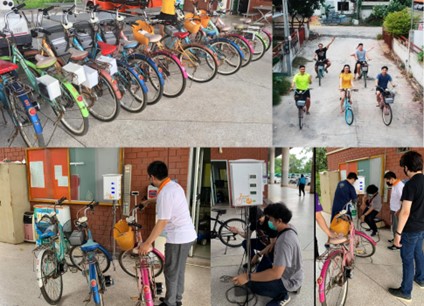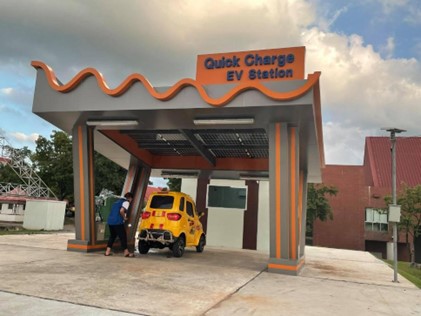
 Greenhouse gas emission reduction program | Suranaree University of Technology
Greenhouse gas emission reduction program | Suranaree University of Technology
1. SUT-E-Bike with Solar Power Charging Station
Suranaree University of Technology (SUT) is a large community. Therefore, there are thousands of students and staff commuting inside and around the university. In SUT, the buildings are far from each other. As a result, there is a high demand for short distances within the university. Most trips involve private cars or motorcycles, e.g., 1 person per 1 vehicle. This results in the accumulation of air pollution and may cause carbon dioxide emissions.
Even though the university has provided bicycles for students and staff to use for commuting within the university, they are not popular for long distance travel, especially in the summer. Therefore, in this project, we converted normal bicycles into electric bicycles using a simple system that is easy to maintain and reproduce. In addition, we designed and built a pilot solar power charging station for these electric bicycles. This project is expected to further promote the use of clean energy vehicles within the university in the future.
Quick Charge EV with Solar Power Station
We established a charging station to support electric vehicle use. This involved designing and constructing a charging station to support the use of electric vehicles. university in the future.
Smart Electric Motorcycle Service Project in the university area” or MoreSai @ SUT
This aims to create more travel options within the university and serves students without motorcycles. The speed of the vehicle is limited to reduce the chances of an accident. There is a limited area of use within the university enforced with geo-fencing technology and the vehcile helps to reduce air pollution. You can use the service via the MoreSai app at https://www.moresai.com/download-link.html.
The fixed-bed downdraft gasification method used in this gasification power prototype plant includes a plasma system as an additional heat source. This power plant uses infectious wastes gathered from SUT Hospital and refuse-derived fuel (RDF). The plant comprises four processes: a system for conveying waste fuel, one for producing fuel gas, one for purifying fuel gas, and one for generating power. With the ability to manage and maintain a furnace at a very high temperature, this gasification power prototype plant can eliminate waste with a high degree of efficiency. The electricity is used by the plasma arc technique to heat the air (a mixture of N2 and O2 gas) to 2000 degrees to produce the plasma.
Organic and Inorganic Waste Disposal Plant: Integrated Solid Waste Sorting Plant
The Suranaree University of Technology manages its organic and inorganic wastes at the Integrated Solid Waste Sorting Plant. This facility composts or uses Mechanical Biological Treatment (MBT) technology. The waste processing process includes a waste segregation system using a conveyor belt, grinder machine, MBT system, and sieve machine to separate organic compost and plastics for the waste processing process. The waste processing process converts waste into organic compost and Refuse Derived Fuel (RDF).
93% of the total trash (1,468 Ton/Year) is made up of recyclable wastes, RDF, and organic compost, totaling 1,140 Ton/Year. The waste processing method results in the production of 663 Tons of RDF and 477 Tons of organic compost each year.
 Suranaree University of Technology | Innovation & Sustainable University
Suranaree University of Technology | Innovation & Sustainable University 





